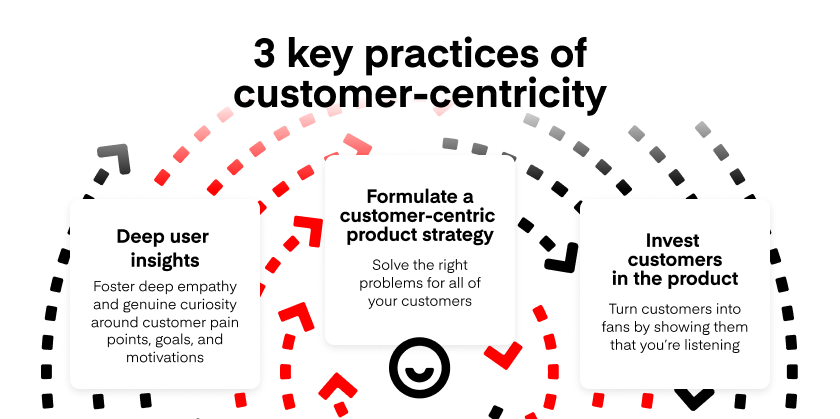Ein Produkt herzustellen ist einfach. Ein Produkt herzustellen, das Ihre Kunden LIEBEN, ist schwer. Oder doch? Werfen wir einen Blick auf die 10 besten Wege, um eine kundenorientierte Produktentwicklung zu meistern und Ihre Kunden in eine Position zu bringen, in der sie nicht anders können, als zu Ihrem Produkt zurückzukehren.
Doch zunächst einmal: Was verstehen wir unter kundenorientierter Produktgestaltung?
Kundenorientiertes Produktdesign
Kundenorientiertes Produktdesign ist genau das, was auf dem Etikett steht. Es ist eine Methode, ein Produkt kundenorientiert zu gestalten. Im Wesentlichen bauen Sie für Ihre Benutzer, anstatt Benutzer für etwas zu finden, das Sie gebaut haben. Es ist eine Art, den Kunden während der gesamten Produktentwicklungsphase im Auge zu behalten.

Quelle: Productboard.
Laut Productboard gibt es 3 wichtige Praktiken, die bei der Kundenorientierung zu beachten sind:
- Tiefe Einblicke in die Nutzer
- Formulierung einer kundenzentrierten Produktstrategie
- Kunden in das Produkt investieren
Tiefe Einblicke in die Nutzer
Um "tiefes Einfühlungsvermögen und echte Neugier für die Schmerzpunkte, Ziele und Motivationen der Kunden zu fördern", muss Ihr Team so oft wie möglich mit den Kunden interagieren, sie bei der Nutzung Ihres Produkts genau beobachten und ein UX-Forschungs-Repository einrichten, damit die Erkenntnisse von jedem im Unternehmen geteilt und leicht abgerufen werden können. Im Idealfall sollte jeder im Unternehmen zur Teilnahme ermutigt werden, um eine Arbeitskultur zu schaffen, die den Austausch von Erkenntnissen fördert.
Kundenzentrierte Produktstrategie
Um die Probleme Ihrer Kunden zu lösen, müssen Sie zunächst verstehen, was sie brauchen. Dies erfordert eine umfangreiche Nutzerforschung und die Erstellung eines kundenorientierten Priorisierungsrahmens. Schaffen Sie grundsätzlich ein Gleichgewicht zwischen dem Überschreiten von Grenzen durch neue Innovationen und dem Beheben von Schmerzpunkten der Nutzer.
Kunden in das Produkt investieren
Auch wenn wir die Kunst der alchemistischen Verwandlung noch nicht beherrschen, so haben wir doch das Glück, dass es im Vergleich dazu recht einfach ist, Kunden zu Stammkunden zu machen. Man muss nur zuhören, was sie sagen, und die notwendigen Anpassungen vornehmen. Halten Sie sie auf dem Laufenden, was in der Pipeline ist, und lassen Sie sie an Ihrer Produktvision teilhaben - das wird Ihnen helfen, eine emotionale Bindung aufzubauen.
Kundenorientiertes Produktmanagement
Wie verwandeln Sie also diese drei Schlüsselpraktiken in ein Qualitätsprodukt, von dem die Kunden nicht genug bekommen können?
Hier sind zehn Tipps, die Ihnen helfen, die Bedürfnisse des Kunden in Ihren Designprozess einzubeziehen.
10 Wege zur Beherrschung der kundenzentrierten Produktentwicklung
1. Nutzereinblicke zugänglich machen
Eines der grundlegendsten Dinge, die Sie für Ihr Unternehmen tun müssen, ist, Ihre Nutzerdaten für alle leicht zugänglich zu machen. Sie können die besten Nutzererkenntnisse der Welt haben, aber was nützt das, wenn Ihre Stakeholder keinen Zugang zu ihnen haben? Wenn Ihre Produktdesigner nicht verstehen, was die Nutzer wollen, weil die Nutzerforscher nicht in der Lage waren, die Gedanken der Kunden in der richtigen Weise zu vermitteln, dann wird Ihr Produkt niemals kundenorientiert sein.
Die besten Forschungsdatenbanken sind diejenigen, auf die Ihr gesamtes Team zugreifen kann. Sie sollten nicht schwer zu erlernen oder zu verstehen sein. Dies gibt Ihnen die Möglichkeit zu wissen, was der Kunde denkt und braucht - etwas, das ALLE Unternehmen haben sollten, vor allem wenn ihr Schwerpunkt auf kundenorientiertem Produktdesign liegt.
tl;dv
tl;dv ist das ideale remote , wenn Sie Ihre Forschung auf eine leichter zugängliche Weise dokumentieren möchten. Es ermöglicht Ihnen, Erkenntnisse direkt aus dem Mund des Nutzers zu gewinnen und sie in kurze Clips umzuwandeln, die mit einem einfachen Kopieren und Einfügen geteilt werden können. Jetzt können Nutzerforscher eine Reihe von kurzen Highlights aus ihren Nutzerinterviews sammeln und sie sofort mit Entscheidungsträgern teilen, damit diese die Bedenken oder das Lob direkt von der Stimme des Kunden hören können.
Es gibt keinen Platz für Voreingenommenheit. Es gibt keinen Platz für schlampige Notizen oder unemotionale Aktionspunkte. Es gibt keinen Platz für etwas anderes als die kalte, harte Wahrheit.

Und als kostenloser Online-Meeting-Recorder mit unbegrenzten Aufzeichnungen, Abschriften, Zeitstempeln, Bearbeitung und der Möglichkeit, Kollegen zu markieren, ist tl;dv das perfekte Tool, um Produktbesprechungen zu verfolgen. Sie können auf Ihre Meeting-Bibliothek zugreifen, um alle Google Meet oder Zoom zu durchsuchen und so ganz einfach vergangene Sprint-Reviews, Planungen, Fehlerberichte, Entscheidungen und mehr zu finden.
Haben wir schon erwähnt, dass all diese Funktionen völlig kostenlossind... für immer!
2. Verlassen Sie sich nicht auf Ihre Produkt-Roadmap
Produkt-Roadmaps sind eine tolle Sache, verstehen Sie mich nicht falsch! Aber manchmal werden sie ein wenig überschätzt. Wenn es um Kundenzentrierung geht, wird aus dem "manchmal" ein "immer".
Denken Sie einfach daran: Wenn Ihr Kunde Sie anfleht, einen bestimmten Weg einzuschlagen, Sie aber an Ihrer starren Roadmap festhalten, dann wird Ihr Kunde am Ende unzufrieden sein, und Sie werden mit einem Produkt dastehen, das Sie von Anfang an geplant hatten, das aber keine Nutzer hat. Kunden sind alles.
Um es einfach auszudrücken: Lassen Sie Ihren Fahrplan beiseite und hören Sie auf Ihre Kunden. Das wird für Sie beide besser sein.
3. Genaue Dokumentation der Benutzereinblicke
Ähnlich wie beim ersten Punkt über die Zugänglichkeit sind die Erkenntnisse der Benutzer nur so wertvoll wie die Art und Weise, wie sie dokumentiert werden. Es gibt zwar Dutzende von gängigen Dokumentationswerkzeugen, die Sie für eine solche Aufgabe verwenden können, aber es gibt einige Dinge, die Sie zunächst beachten sollten.
Ihre Nutzereinblicke sollten 3 Dinge tun:
- Zugänglich sein
- Abschöpfbar sein
- Erzählen Sie das ganze Bild mit Beweisen
Die Barrierefreiheit wurde bereits als wichtigster Punkt auf dieser Liste genannt, denn ohne sie wären Sie, ehrlich gesagt, aufgeschmissen. Der Rest wäre nicht einmal von Bedeutung.
Um überfliegbar zu sein, müssen Ihre Benutzereinblicke in einem Dokumentationswerkzeug enthalten sein, das leicht zu organisieren und vorzugsweise visuell ist. Es ist viel einfacher, etwas visuell Ansprechendes zu überfliegen als eine riesige Textwand. Verwenden Sie Überschriften, um den Text aufzulockern, oder machen Sie die wichtigen Teile fett.

Um das ganze Bild mit Beweisen zu erzählen, brauchen Sie unvoreingenommene Beweise. Wenn Sie tl;dv verwenden, um Ihre Nutzerinterviews aufzuzeichnen, zu transkribieren und kurze Clips zu erstellen, erfüllen Sie alle drei Kriterien: zugänglich, überschaubar und mit Beweisen untermauert.
Probieren Sie es aus auf Google Meet oder Zoom noch heute kostenlos.
4. Einsatz eines kundenzentrierten Rahmens
Für ein kundenorientiertes Produktmanagement müssen Sie das richtige Framework verwenden. Wir denken, dass Jobs-To-Be-Done das Nonplusultra ist, und wenn Sie keine Ahnung von Frameworks haben, sollten Sie hier anfangen.
Die Annahme eines solchen Rahmens wird Ihnen helfen:
- Verbesserter Kundeneinblick - tiefere Einblicke in die Gründe, warum Kunden bestimmte Produkte kaufen und wie sie diese in verschiedenen Kontexten verwenden
- Erhöhte Produkteffektivität - Verbessern Sie Ihr aktuelles Produkt, nachdem Sie die Beweggründe des Kunden genau verstanden haben
- Kürzere Innovationszyklen - wenn Sie verstehen, was Ihre Kunden wollen, können Sie sich schneller mit der Materie befassen.
- Mehr Kundentreue - wenn Sie eine Lösung für die Bedürfnisse eines Kunden bieten, wird er zufrieden sein. Wenn dies in allen Bereichen geschieht, maximieren Sie die Kundentreue
Welchen Rahmen Sie auch immer verwenden, stellen Sie sicher, dass er kundenorientiert ist.
5. Öffne deinen Geist

Wenn Sie unvoreingenommen an eine Aufgabe herangehen - oder an irgendetwas anderes -, lassen Sie Ihre Programmierungen herausfallen. Meistens ist das eine gute Sache. Stellen Sie sich vor, Sie sprechen mit Ihren Kunden und verstehen wirklich, was sie zu sagen haben: ihre Wünsche, Bedürfnisse und Hoffnungen. Wenn Sie aufgeschlossen sind, können Sie auf diese Rohdaten zugreifen, indem Sie ihnen einfach die richtigen Fragen stellen.
Wenn Sie unvoreingenommen an die Aufgabe herangehen, können Sie alle Nuggets ausschöpfen, die Sie bekommen können. Auf diese Weise wird der Kunde das Produkt gestalten.
Treten Sie nicht als der große Besserwisser auf, der glaubt, die Probleme und Vorlieben der Kunden zu kennen. Überlassen Sie das Reden dem Nutzer, nehmen Sie es mit tl;dv auf und geben Sie die besten Clips an Ihre Stakeholder weiter, damit diese genau das Gleiche hören können wie Sie.
Die besten Ergebnisse erzielen Sie, wenn Sie ein Benutzerinterview wie den Mom-Test durchführen. Dies ist in der Tat unerlässlich, um die wichtigsten Informationen von Ihren Nutzern zu erhalten. Wenn Sie ein gutes Feedback von Ihrer Mutter bekommen können, warum sollten Sie dann nicht die gleiche Technik anwenden, um ein gutes Feedback von Ihren tatsächlichen Nutzern zu bekommen?
Schlechte Forschung ist schlimmer als gar keine Forschung.
6. Up-To-Date bleiben
Die kundenorientierte Produktgestaltung unterliegt einem ständigen Wandel. Neue Vordenker schaffen neue Paradigmen. Neue Innovationen ebnen den Weg für neue Erfindungen. Wenn Sie in Ihrem Fachgebiet auf dem Laufenden bleiben, können Sie Ihren Platz an der Spitze der Innovation behaupten.
Wenn Sie auf der Suche nach erstklassigen Büchern für Produktmanager sind, sollten Sie sich unsere Leseliste 2023 ansehen.
Sie können auch Ihren Lieblingsautoren, -rednern oder -designern in den sozialen Medien folgen und zuhören, was sie zu sagen haben. Sie geben oft Wissen preis, das Sie nutzen können, um Ihren Prozess zu verbessern.

7. Diversifizieren, Diversifizieren, Diversifizieren!
Nein, wir reden hier nicht über Handelsportfolios. Wir sprechen über die Quellen für die Interaktion mit Ihren Kunden. Sie wollen zum Beispiel Ihre Kundeninformationen nicht nur aus Amazon-Rezensionen erhalten. Genauso wenig sollten Sie sie nur aus Nutzerbefragungen gewinnen. Der beste Prozess ist einer, der alle Interaktionen mit dem Kunden in einen einzigen, soliden Aktionsplan integriert.
Die Diversifizierung sollte zwar auch auf granularer Ebene erfolgen, z. B. bei der Auswahl der Teilnehmer für Ihre Nutzerinterviews, aber auch bei der Auswahl der Quellen, aus denen Sie produktveränderndes Wissen gewinnen können.
Hier sind einige Möglichkeiten, wie Sie die Art und Weise, wie Sie Informationen von Ihren Kunden erhalten, diversifizieren können:
- Holen Sie sich G2-Bewertungen von Ihren eigenen Tools und von Wettbewerbern
- Anhören von Gesprächen zur Unterstützung
- Auf Reddit gehen
- Sprung auf Benutzeranrufe
- Durchführung einer NPS-Umfrage
- Verwendung von Apps zur Verfolgung der Benutzerfreundlichkeit und anderen Tools zur Benutzerforschung
- Von Angesicht zu Angesicht reden (wie in den guten alten Zeiten)
Je mehr Möglichkeiten Sie haben, Informationen von Ihren Nutzern zu erhalten, desto besser.
8. Produktmanager sollen Support-Fälle bearbeiten
Der schnellste Weg für einen Produktmanager, die Probleme der Benutzer wirklich zu verstehen, ist die Zusammenarbeit mit dem Kundensupportteam bei Supportfällen. Wenn sie die Probleme der Nutzer hören, können sie sich besser in sie hineinversetzen und verstehen, wie man eine wichtige Änderung vornehmen kann, die das Leben aller Beteiligten einfacher macht.
Das lohnt sich vor allem dann, wenn es Ihr erster Monat im Job ist und Sie ein Gefühl dafür bekommen müssen, wie sich die Benutzer schnell fühlen, oder wenn Sie kürzlich eine neue Funktion veröffentlicht oder die UX überarbeitet haben.
9. Rechenschaftspflicht
Bringen Sie Ihr Kundensupportteam und Ihr Produktteam dazu, sich gegenseitig zur Verantwortung zu ziehen. Wenn das Produktteam den größten Schmerzpunkt des Nutzers nicht anspricht, muss das Kundenserviceteam es so schnell wie möglich mit unwiderlegbaren Beweisen darauf hinweisen (ein weiterer Grund, warum das gesamte Team auf das Forschungsarchiv zugreifen und es ergänzen können sollte).
Ähnlich verhält es sich, wenn das Support-Team gemeinsame Probleme nicht effektiv anspricht, dann werden sie auch nicht angegangen. Es ist eine zweiseitige Straße, und es muss unbedingt eine Zusammenarbeit geben, damit es funktioniert.
Richten Sie Kanäle ein, um Feedback von den Support-Teams zu sammeln und sicherzustellen, dass es nicht verloren geht, ignoriert oder vergessen wird.
Um den Kreislauf zu schließen, sollte das Produktteam, wenn es einen häufigen Schmerzpunkt behoben hat, den Benutzer informieren und ihn wissen lassen, dass sein Wort geschätzt und befolgt wurde. Dadurch wird die Loyalität der Nutzer gestärkt und sie wissen, dass sie etwas Positives bewirkt haben.
10. Nutzen Sie die tl;dvProduktgemeinschaft
Wir stellen Ihnen die tl;dv dv-Produkt-Community vor, einen anonymen Raum, in dem Sie unvoreingenommene Unterstützung und Ratschläge zu Ihrem Produkt erhalten.
Wir wissen, dass es schwierig sein kann, Ihr Produkt mit den Bedürfnissen Ihrer Kunden in Einklang zu bringen, aber dieser Raum steht Ihnen völlig offen, um sich Luft zu machen, Fragen zu stellen oder Ratschläge von anderen produktbegeisterten Menschen zu erhalten.
Schauen Sie bei uns vorbei, wenn Sie Fragen zu Produkten, Problemen, Tiraden und Ratschlägen haben, die tagtäglich auftreten.
Sie können auch tl;dv, die Produktforschungssoftware, für die Aufnahme, Transkription und Erstellung kurzer Highlights Ihrer Nutzerforschung in Sekundenschnelle erhalten.














